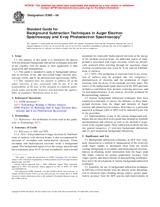We need your consent to use the individual data so that you can see information about your interests, among other things. Click "OK" to give your consent.
ASTM E995-04
Standard Guide for Background Subtraction Techniques in Auger Electron Spectroscopy and X-ray Photoelectron Spectroscopy
STANDARD published on 1.7.2004
The information about the standard:
Designation standards: ASTM E995-04
Note: WITHDRAWN
Publication date standards: 1.7.2004
SKU: NS-48725
The number of pages: 4
Approximate weight : 12 g (0.03 lbs)
Country: American technical standard
Category: Technical standards ASTM
Annotation of standard text ASTM E995-04 :
Keywords:
Auger electron spectroscopy, background subtraction, surface analysis, X-ray photoelectron spectroscopy, ICS Number Code 17.180.30 (Optical measuring instruments)
Additional information
| Significance and Use | ||||
|
Background subtraction techniques in AES were originally employed as a method of enhancement of the relatively weak Auger signals to distinguish them from the slowly varying background of secondary and backscattered electrons. Interest in obtaining useful information from the Auger peak line shape, concern for greater quantitative accuracy from Auger spectra, and improvements in data gathering techniques, have led to the development of various background subtraction techniques. Similarly, the use of background subtraction techniques in XPS has evolved mainly from the interest in the determination of chemical states (binding energy values), greater quantitative accuracy from the XPS spectra, and improvements in data acquisition. Post-acquisition background subtraction is normally applied to XPS data. The procedures outlined are popular in XPS and AES. General reviews of background subtraction techniques have been published (1 and 2 ).3 |
||||
| 1. Scope | ||||
|
1.1 The purpose of this guide is to familiarize the analyst with the principal background subtraction techniques presently in use together with the nature of their application to data acquisition and manipulation. 1.2 This guide is intended to apply to background subtraction in electron, X-ray, and ion-excited Auger electron spectroscopy (AES), and X-ray photoelectron spectroscopy (XPS). 1.3 This standard does not purport to address all of the safety concerns, if any, associated with its use. It is the responsibility of the user of this standard to establish appropriate safety and health practices and determine the applicability of regulatory limitations prior to use. |
||||
| 2. Referenced Documents | ||||
|
We recommend:
Technical standards updating
Do you want to make sure you use only the valid technical standards?
We can offer you a solution which will provide you a monthly overview concerning the updating of standards which you use.
Would you like to know more? Look at this page.




 Cookies
Cookies
